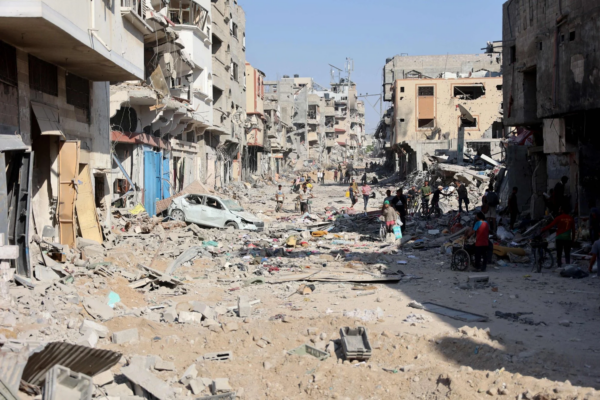Bodies trapped in Gaza City under Israeli assault as mediators push for truce
By Nidal Al-Mughrabi and Dawoud Abu Alkas
Israeli Prime Minister Benjamin Netanyahu on Thursday accused Palestinian militant group Hamas of making demands in talks on a possible ceasefire in Gaza that contradict a framework deal brokered by Washington.
While Netanyahu spoke, some residents of Gaza City were trapped in houses and bodies lay uncollected in the streets after an intense new Israeli assault that Hamas says could wreck the prospects of a ceasefire.
Washington is pushing for a peace deal at talks in Egypt and Qatar to end the Gaza war, now in its tenth month. The head of Israel’s Shin Bet intelligence agency was headed to Cairo to pursue the negotiations, Netanyahu’s office said.
Speaking at a military ceremony in Israel, Netanyahu said: “I am committed to the framework deal for freeing our hostages, but the Hamas murderers are sticking to demands that contradict the framework, that endanger Israel.”
He did not say what those demands were.
In Washington, White House National Security Adviser Jake Sullivan said many details still need to be hammered out to secure a deal.
“There’s still miles to go before we close if we are able to close. So I don’t want to say that it’s immediately around the corner, but it does not have to be far out in the distance if everyone comes in this with the will to get it done,” Sullivan told reporters.
In a statement, the Palestinian Islamist militant group said mediators had yet to provide it with updates on the state of the talks since it made concessions last week in response to a U.S.-backed Israeli peace offer.
Residents of Gaza City say this week’s assault is comparable to the fiercest battle of the war, which destroyed the enclave’s oldest and biggest settlement in the first weeks of fighting last year.
Home to more than a quarter of Gaza’s residents before the war, Gaza City was largely razed to the ground in late 2023, but hundreds of thousands of Palestinians have returned to homes in the ruins. They have now once again been ordered out by the Israeli military. Many say they won’t go.
“We will die but not leave to the south. We have tolerated starvation and bombs for nine months and we are ready to die as martyrs here,” said Mohammad Ali, 30, reached by text message.
Ali, whose family has relocated several times within the city, said they had been running short of food, water and medicine.
“The occupation (Israel) bombs Gaza City as if the war was restarting. We hope there will be a ceasefire soon, but if not then is God’s will.”
The Gaza health ministry said it had reports of people trapped and others killed inside their houses in the Tel Al Hawa and Sabra districts of Gaza City, and rescuers could not reach them.
The Civil Emergency Service said it estimated that at least 30 people had been killed in the Tel Al-Hawa and Rimal areas and it could not recover bodies from the streets there.
The Israeli army told Gaza City residents on Wednesday to use two “safe routes” to head south. Some posted a hashtag on social media: “We are not leaving”.
Asked by Reuters to comment on its operations in Gaza city, the Israeli military said in a statement its forces were working to dismantle Hamas capabilities, and that it “follows international law and takes feasible precautions to mitigate civilian harm.” It said the same was not true of Hamas.
HAMAS: ISRAEL IS STALLING
The negotiations in Qatar and Egypt follow important concessions last week from Hamas, which accepted that a truce could begin and some hostages be released without Israel first agreeing to end the war.
In its statement on Thursday, the group accused Israel of “stalling to buy time to foil this round of negotiations, as it has done in previous rounds”, all of which have ended in failure since a week-long truce in November.
Just east of Gaza City in the Shejaia suburb, residents were returning on foot to a desolate moonscape of destroyed buildings after Israeli forces withdrew following a two-week offensive.
The territory’s main cemetery had been bulldozed by the army. People wheeled supplies on the back of bicycles across rubble-strewn tracks, passing the remains of burnt-out and blasted Israeli armoured vehicles.
“We have returned to Shejaia after 15 days. You can see the destruction. They spared nothing, even trees, there was a lot of greenery in this area. What is the guilt of stones and trees? And what is my guilt as a civilian?” resident Hatem Tayeh told Reuters in the ruins.
“There are bodies of civilian people. What is the guilt of the civilian? Who are you fighting?”
Israel launched its assault on the Gaza Strip last year after Hamas-led militants stormed into southern Israel, killing 1,200 people and capturing more than 250 hostages according to Israeli tallies.
Since then, Israel’s assault has killed more than 38,000 according to medical authorities in Gaza.
Reuters
Advertisement · Scroll to continue

Leave a Reply
You must be logged in to post a comment.